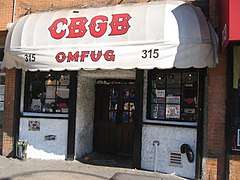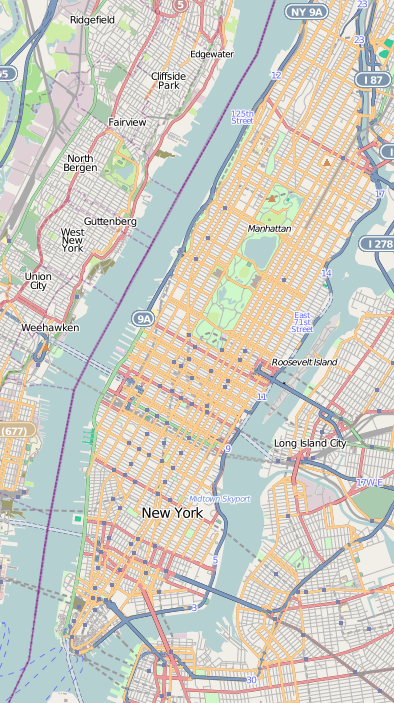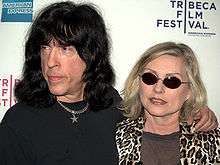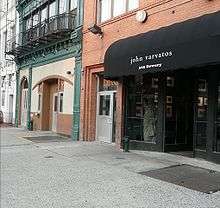CBGB
CBGB was a New York City music club opened in 1973 by Hilly Kristal in Manhattan's East Village.
 Front of CBGB, circa 2005 | |
 CBGB Location within Manhattan  CBGB CBGB (New York City)  CBGB CBGB (New York) | |
| Location | Manhattan, New York City, New York, USA |
|---|---|
| Owner | Hilly Kristal |
| Capacity | 350[1] |
| Opened | December 10, 1973 |
| Closed | October 15, 2006 |
| Website | |
| CBGB.com | |
CBGB | |
| Location | 315 Bowery Manhattan, New York City, New York, United States |
| Coordinates | 40°43′31″N 73°59′31″W |
| Built | 1878 |
| Part of | The Bowery Historic District (ID13000027) |
| Added to NRHP | February 20, 2013 |
The club was previously a biker bar and before that was a dive bar.[2] The letters CBGB were for Country, BlueGrass, and Blues, Kristal's original vision, yet CBGB soon became a famed venue of punk rock and new wave bands like the Ramones, Television, Patti Smith Group, Blondie, and Talking Heads. From the early 1980s onward, CBGB was known for hardcore punk.[3]
One storefront beside CBGB became the "CBGB Record Canteen", a record shop and café. In the late 1980s, "CBGB Record Canteen" was converted into an art gallery and second performance space, "CB's 313 Gallery". CB's Gallery was played by music artists of milder sounds, such as acoustic rock, folk, jazz, or experimental music, such as Dadadah, Kristeen Young and Toshi Reagon, while CBGB continued to showcase mainly hardcore punk, post punk, metal, and alternative rock. 313 Gallery was also the host location for Alchemy, a weekly Goth night showcasing goth, industrial, dark rock, and darkwave bands[4][5]. On the other side, CBGB was operating a small cafe and bar in the mid-1990s, which served classic New York pizza, among other items.[6][7]
Around 2000, CBGB entered a protracted dispute over allegedly unpaid rent amounts until the landlord, Bowery Residents' Committee, sued in 2005 and lost the case, but a deal to renew CBGB's lease, expiring in 2006, failed. The club closed upon its final concert, played by Patti Smith, on October 15, 2006.[8] CBGB Radio launched on the iHeartRadio platform in 2010, and CBGB music festivals began in 2012.[9] In 2013, CBGB's onetime building, 315 Bowery, was added to the National Register of Historic Places as part of The Bowery Historic District (not a New York City Historic District).[10]
Founding
CBGB was founded on December 10, 1973,[11] on the site of Kristal's earlier bar, Hilly's on the Bowery, that he ran from 1969 to 1972. Initially, Kristal focused on his more profitable East Village nightspot, Hilly's, which Kristal closed amid complaints from the bar's neighbors. After Hilly's closure, Kristal focused on the Bowery club. Its full name of CBGB & OMFUG stands for "Country, Bluegrass, Blues and Other Music for Uplifting Gormandizers". Although a gormandizer is usually a ravenous eater of food, what Kristal meant was "a voracious eater of... music".[12] Kristal's intended theme of country, bluegrass, and blues music along with poetry readings yielded to the American movement in punk rock. A pioneer in the genre, the Ramones played their first shows at CBGB.[13]
Evolution
In 1973, while the future CBGB was still Hilly's, two locals—Bill Page and Rusty McKenna—convinced Kristal to let them book concerts. In February 1974, Hilly booked local band Squeeze to a residency, playing Tuesdays and Wednesdays, the club's change from country and bluegrass to original rock bands. Squeeze was led by guitarist Mark Suall, later with CBGB's quasi house band the Revelons, which included Fred Smith of Television and JD Daugherty of the Patti Smith Group. Although these bands did not play punk rock, they helped lay its foundation.[14] The August 1973 collapse of the Mercer Arts Center left unsigned bands little option in New York City to play original music. Mercer refugees—including Suicide, The Fast,[15] Ruby and the Rednecks, Wayne County, and the Magic Tramps—soon played at CBGB.

In 1974, on April 14, in the audience of Television's third gig were Patti Smith and Lenny Kaye, whose Patti Smith Group debuted at CBGB on February 14, 1975. Other early performers included the Dina Regine Band. Dennis Lepri was lead guitarist as well as the Stillettoes which included Deborah Harry on vocals. The newly formed band Angel and the Snake, later renamed Blondie, as well as the Ramones arrived in August 1974. Mink DeVille, Talking Heads, the Shirts, the Heartbreakers, the Fleshtones and other bands soon followed. In April 1977, The Damned played the club, marking the first time a British punk band had ever played in America.[16]
During 1975 and 1976, Metropolis Video recorded some shows on film. Starting in 1977, Metropolis Video filmmaker Pat Ivers and partner Emily Armstrong continued to record shows in a project called Advanced TV, later renamed GoNightclubbing. Ivers' and Armstrong's films are available at the New York University Fales Library.[17]
CBGB's two rules were that a band must move its own equipment and play mostly original songs—that is, no cover bands—although regular bands often played one or two covers in set.[18] CBGB's growing reputation drew more and more acts from outside New York City. In 1978, new wave songwriter Elvis Costello would open shows for The Voidoids, while The Police played at CBGB for their first American gigs. Meanwhile, CBGB became famed for the Misfits, Television, Patti Smith Group, Mink DeVille, the Dead Boys, the Dictators, the Fleshtones, the Voidoids, the Cramps, the B-52's, Blondie, Joan Jett & the Blackhearts, the Shirts, and Talking Heads. Yet in the 1980s, hardcore punk's New York underground was CBGB's mainstay. Named "thrash day" in a documentary on hardcore, Sunday at CBGB was matinée day, which became an institution, played from afternoon until evening by hardcore bands.[19] In 1990, violence inside and outside of the venue prompted Kristal to suspend hardcore bookings, although CBGB brought hardcore back at times. CBGB's last several years had no formal bans by genre.
Rent controversy
In 2005, atop its normally paid monthly rent of $19,000, CBGB was sued for some $90,000 in rent allegedly owed to its landlord, Bowery Residents' Committee (BRC).[20] Refusing to pay until a judge ruled the debt legitimate, Kristal claimed that he had never been notified of scaled rent increases, accruing over a number of years, asserted by BRC's executive director Muzzy Rosenblatt.[20] Ruling the debt false—that BRC had never properly billed the rent increases[20]—the judge indicated that CBGB ought to be declared a landmark, but noted that Rosenblatt did not need to renew the lease, soon expiring.[21] Rosenblatt vowed to appeal.[21]
Expecting Rosenblatt's resistance to lease negotiation,[20] Kristal agreed that the rent ought to rise, but not to the $55,000 monthly that Kristal believed the BRC to want.[21] A nonprofit corporation housing homeless above CBGB mostly through donations and government funding,[20] the BRC had only one commercial tenant and raised its monthly rent to $35,000.[22] Kristal and the BRC reached an agreement whereby CBGB would leave by September 30, 2006.[22] Planning to move CBGB to Las Vegas, Kristal explained, "We're going to take the urinals. I'll take whatever I can. The movers said, 'You ought to take everything, and auction off what you don't want on eBay.' Why not? Somebody will."[23]
Closure
Many punk rock bands played at CBGB when they found it was going to close in hopes that their support could keep it from closing. Rocks Off, a promoter in New York, organized CBGB's final weeks of shows to book "many of the artists who made CB's famous".[22] Avail, the Bouncing Souls, and such newer acts opened during the last week, which included multi-night stands by Bad Brains and the Dictators and an acoustic set by Blondie. The final show, broadcast live on Sirius Satellite Radio on October 15, was played by Patti Smith, helped on some songs by Flea of the Red Hot Chili Peppers. Television's Richard Lloyd, too, played in a few, including "Marquee Moon". Nearly finished, Smith and band playing "Gloria" alternated the chorus with echos of "Blitzkrieg Bop"—by the Ramones—Hey! Ho! Let's go!. During "Elegie", her final encore, Smith named musicians and other music figures who had died since playing at CBGB.[24] On October 15, 2006, upon Patti Smith's last show at CBGB, the storied bar and club closed.[25]
Aftermath
After closing, the old CBGB venue remained open as CBGB Fashions—retail store, wholesale department, and an online store—until October 31, 2006. CBGB Fashions moved to 19–23 St. Mark's Place on November 1, and closed nearly two years later in summer 2008.[26]
Hilly Kristal died from complications of lung cancer on August 28, 2007. In early October, Kristal's family and friends hosted a private memorial service in the nearby YMCA. Soon, there was a public memorial, contributed to by CBGB onetime staff and by others.
Kristal's ex-wife Karen Kristal and his daughter, Lisa Kristal Burgman, battled legally over the purported $3 million CBGB estate, and settled in June 2009 with Burgman receiving most of the money left after payment of creditors and estate taxes.[27] In 2011, a group of unknown investors bought the remaining CBGB assets, including the associated intellectual property and original interior. The location is now occupied by John Varvatos fashions.
In December 2015, various news outlets reported on a rebranded CBGB "reopening" at Newark International Airport - as CBGB L.A.B. (Lounge and Bar)[28][29] by New York Chef chef Harold Moore; which had opened as of the end of December 2015.
Venue

_P001.jpg)
By late 2007, fashion designer John Varvatos planned to open a store in CBGB's former space, 315 Bowery,[30] but to tastefully trail CBGB's legacy[31] rock and roll stickers on the walls, and much of the graffiti at the toilets was preserved, as were some playbills, found behind a wall, from shows at the club's 10th anniversary in 1983.[32] The store opened in April 2008.[33]
In 2008, a SoHo art gallery dedicated to music photography, the Morrison Hotel, opened a second location in the onetime CBGB Gallery at 313 Bowery,[32] but the Morrison Hotel gallery closed in 2011.[34] The building is currently occupied by Patagonia, a clothing store.[35]
Called the "Extra Place", the alley behind the building became a pedestrian mall. The Dead Boys' Cheetah Chrome rued, "All of Manhattan has lost its soul to money lords", yet reflected, "If that alley could talk, it's seen it all".[36] CBGB's nomination as a landmark drew an explanation:
CBGB was founded in 1973 at 315 Bowery, in a former nineteenth-century saloon on the first floor of the Palace Lodging House. The legendary music venue fostered new genres of American music, including punk and art rock, that defined the culture of downtown Manhattan in the 1970s, and that still resonate today. In this role as cultural incubator, CBGB served the same function as the theatres and concert halls of the Bowery's storied past. The former club, now occupied by a retail business, remains a pilgrimage site for legions of music fans.[10]
Today visitors can see etched into the cement at the entrance to the clothing store, the name of the music venue and the date it was founded "CBGB '73". People often stop and take pictures of the inscription as well as the facade of the store.
Influence
CBGB's awning was moved into the lobby of the Rock and Roll Hall of Fame in Cleveland. The CBGB Festival produced large free concerts in Times Square and Central Park on July 7, 2012. They also showcased hundreds of bands in venues across the city. The festival premiered dozens of rock-n-roll movies in theaters around Manhattan. Directed by Randall Miller and starring Alan Rickman as Hilly Kristal, the film CBGB, about Kristal and the origins of the club, was released in October 2013[37][38] to harsh reviews.[39][40] Iconic in American popular culture, CBGB's image remained storied:
- CBGB was in a promotional ad aired during New York City's bid to host the Olympic Games 2012.[41]
- CBGB appears in the 2010 rhythm game Guitar Hero: Warriors of Rock.[42]
- Talking Heads' song "Life During Wartime" declares, "This ain't no Mudd Club or CBGB..."[43]
- A scene in Woody Allen's Hannah and Her Sisters involving Allen and Dianne Wiest watching 39 Steps was filmed at CBGB.
- In Bandslam, CBGB is shown as the favorite place of central character William Burton with a visit to the closed club.
- In Spike Lee's 1999 movie Summer of Sam, Richie becomes a punk rocker and thereupon a regular patron of CBGB.
- The Simpsons' episode "Love, Springfieldian Style" shows a CBGB named "Comic Book Guy's Bar".
- Californication opened its sixth season with the first scene of the episode "The Unforgiven" set in CBGB, where Karen, working as a bartender, first meets Hank. CBGB was also mentioned in other episodes of Californication.
- In the novel Nick and Norah's Infinite Playlist, Nick and Norah break into the closed CBGB.
- In Gilmore Girls, Rory Gilmore's friend Lane Kim's band, Hep Alien, gets booked for a gig at CBGB.
- In Joan Jett & The Blackhearts' clip of "Good Music", Joan Jett skips a fancy dinner party to play a gig at CBGB.
- In an episode of the sketch-comedy series The State, one sketch shows a kid breaking the record for most time spent standing in front of CBGB smoking cigarettes.
- Lana Del Rey tells of a job singing at CBGB in her B-side song "Never Let Me Go".
- In Guns n Roses' music video for their 1987 hit "Sweet Child o' Mine", bass player Duff McKagan wears a T-shirt bearing the CBGB logo.
- In Green Day's music video for their 1994 hit "Welcome to Paradise", drummer Tre Cool wears a T-shirt bearing the CBGB logo.
- In "Losing My Edge" by LCD Soundsystem, James Murphy mentions CBGB as the rock club where he first played Daft Punk to "the rock kids".
- In 13 Going on 30, Matt Flamhaff (Mark Ruffalo) is seen wearing a CBGB shirt.
- The Bon Jovi track "What's Left of Me" on the album What About Now cries, "Why they sold off CBGB's I don't understand".
- In the Broadway musical Rent, Mark recalls the walls of his apartment, shared with Roger, bearing posters having "Roger's picture advertising gigs at CBGB".
- In the movie Sex and the City 2, Carrie Bradshaw's flashback finds her first meeting Samantha while Samantha was working as a bartender at CBGB.
- CBGB appears as a setting in the comic book Amazing Spider-Man Annual #14, from Marvel Comics, published in October 1980.
- CBGB is referenced in the ABC TV show Forever episode 'Punk Is Dead'.
- In The Shapers' song "Old School Punk Star", the venue is referenced in the bridge: "...And to rock on at the CBGB ..."[44]
- In the video for H2O's "What happened", New York-born actor Michael Rappaport asks "what happened to CBGB"
- Sick Of It All's song "A Month Full Of Sundays" reminisces about the matinee hardcore shows at CBGB and features the lines "Now CB's is closed, the building has been sold/They took away the heart but couldn’t kill the soul"
- The finale of HBO's new series about the music industry, Vinyl, includes a scene depicting Hilly Kristal creating the concept for "CBGB & OMFUG".
- CBGB was highlighted in the pilot episode of CBS's Love Monkey.
- Sunderland Punk band Spitfire Bullet's track "New York City" mentions the lyric "Down CBGB'S to see The Ramones them boys are alright Joey's on a roll."
- The British band Half Man Half Biscuit sing the line "I've had the CBGBs" in their song "New York Skiffle" on the album Editor's Recommendation.
- A door canopy can be seen at the Rock & Roll History Museum in the 2006 film, Tenacious D in The Pick of Destiny.
- CBGB can be seen in the background of a cutscene in the video game The Warriors.
- In the film Asthma, Gus says "I miss old New York, like the 70s and 80s, CBGB's, the Ramones, mean streets..."
- The Waterboys song "The Return Of Jimi Hendrix" includes the line "He did a forty-two minute/Cosmic rise in future shocks/Star Spangled Banner/In the back of CBGBs".
- Regina/ Roni wears a CBGB shirt in ABC mini series Once Upon A Time.
- Rapper Aesop Rock mentions CBGB in his song "Shrunk", "Telephone uncovered by purveyors of the ouija/Then checked against the CBGB women's room graffiti"[45]
- In an episode of The CW series "Supernatural," Dean relates a story where he and Sam convince their father, John, to go to New York City and Dean sneaks out to go to CBGB where John finds him drunk.
- In the O.C. season 2 episode 11, actress Mischa Barton who played Marissa Cooper is seen wearing a CBGB t-shirt on loan to her by her love interest Alex Kelly, played by Olivia Wilde.
See also
Notes
- Kokenes, Chris. "CBGB sounds its final note". CNN.
- Bryan Waterman (2011). Television's Marquee Moon. USA: The Continuum International Publishing Group. pp. 66–67. ISBN 978-1-44114-5-291.
- Bands such as Agnostic Front, Murphy's Law, U.S. Chaos, Cro-Mags, Warzone, Gorilla Biscuits, Sick of It All, and Youth of Today became identified with CBGB.
- "Alchemy". www.nycgoth.com. Retrieved July 20, 2018.
- "Alchemy Gothic Mondays".
- "Playing in the neighborhood". New York Times. December 19, 1993. Retrieved April 1, 2010.
- "Pop And jazz guide". New York Times. January 24, 2003. Retrieved April 1, 2010.
- Yahoo Music coverage of concert.
- Marcus Gilmer (May 8, 2012). "CBGB now a festival, could reopen in new location". The A.V. Club. Retrieved May 8, 2012.
- National Register of Historic Places Registration Form: The Bowery Historic District.
- Q magazine, 2002
- Official CBGB website Archived August 8, 2006, at the Wayback Machine.
- Crotty & Lane, "Interview with Hilly", The Mad Monks Guide to NYC, 1999, p 190.
- "Debunking CBGB myths: An interview with Dana, Hilly Kristal's son, Tiny Mix Tapes, September 11, 2007.
- David Nobakht (2005). Suicide: No Compromise. UK: SAF Publishing. p. 222. ISBN 0-946719-71-3.
- aficionado, Binky Philips Music (November 2, 2010). "The Damned at CBGB: The Night Punk Was Officially Born in the USA". Retrieved December 3, 2016.
- "NIGHTCLUBBING Archive by Pat Ivers and Emily Armstrong. MSS 305". dlib.nyu.edu. Retrieved March 8, 2016.
- Kristal's son claims the policy meant to avert owing royalties to ASCAP. "Debunking CBGB myths: An interview with Dana, Hilly Kristal's Son, Tiny Mix Tapes, September 11, 2007.
- Examples include Reagan Youth, Bad Brains, Beastie Boys, Agnostic Front, Murphy's Law, Cro-Mags, Leeway, Warzone, Gorilla Biscuits, Sick of It All, The Misfits, Sheer Terror, Stillborn and Youth of Today.
- Chris Harris, "CBGB doesn't have to pay $90,000 in back rent, judge rules", MTV News, August 10, 2005.
- NY1 News, "Judge rules punk landmark CBGB doesn't owe back rent" Archived July 14, 2014, at the Wayback Machine, Time Warner Cable News: NY1, August 11, 2005.
- Unsigned, "CBGB to shut down on Sept. 30", Billboard website, July 6, 2006.
- "Stars return in CBGB's last shows", BBC News, October 12, 2006.
- Sarah Ventre (September 30, 2010). "How far would you go to see a show". NPR. Retrieved December 22, 2012.
- Sisario, Ben (October 16, 2006). "CBGB Brings Down the Curtain With Nostalgia and One Last Night of Rock". The New York Times. ISSN 0362-4331. Retrieved September 29, 2019.
- Dodero, Camille (March 25, 2008). "CBGB St. Mark's shop closing at the end of June". Village Voice.
- The final CBGB settlement: Hilly Kristal's estate takes its last legal bow Archived June 20, 2009, at the Wayback Machine, Village Voice, June 16, 2009.
- "CBGB to Reopen as Restaurant in Newark Airport". Retrieved December 3, 2016.
- "CBGB Is Reopening At Newark Airport, As A Restaurant". Archived from the original on December 29, 2016. Retrieved December 3, 2016.
- Segal, David (November 2, 2007). "A punk temple reborn: Would you like to see the $200 safety pins?". Washington Post. Retrieved April 1, 2010.
- "Now Opening Saturday Special". Racked.com. January 14, 2008. Retrieved January 16, 2008.
We don't want anyone to walk into the space and say, 'Oh, they screwed it up.' We want them to walk in and say, 'It's not CBGB, but they did the right thing.'
- Karen Brettell (March 27, 2008). "NY gallery keeps punk alive in old CBGB space". Reuters. Retrieved June 30, 2009.
- Ben Sisario (April 19, 2008). "At the former CBGB, the punks once played but the rich now pomp". New York Times. Retrieved May 7, 2008.
- Cuozzo, Steve (March 8, 2011). "WilmerHale eyes 7 WTC". New York Post. Archived from the original on February 16, 2013.
- "Patagonia New York Bowery Store - 313 Bowery NY, NY 10003".
- Jennifer Fermino (March 25, 2008). "Hobo Goes haute". New York Post. Retrieved March 28, 2008.
- "CBGB, new film tells the history of New York City's legendary club". laughingsquid.com. April 10, 2013. Retrieved May 7, 2013.
- "CBGB (2013)". imdb.com. Retrieved December 1, 2013.
- Linda Sickler. "'Punk rock' inventor Legs McNeil coming to Savannah post 'CBGB'". Retrieved December 1, 2013.
- Marc Campbell. "If you thought CBGB's bathrooms were full of shit, check out the movie". Retrieved December 1, 2013.
- NYC 2012 Olympics Promo Video, NYC Olympic Committee via YouTube, (Timecode 1:36–1:49)
- "A Los Angeles Social Diary". Archived from the original on July 29, 2013. Retrieved December 3, 2016.
- Much later, in a related effort, the club played an overtly prominent role in the song "Punk Lolita" by The Heads, a 1996 collaboration of three former Talking Heads members with various guest vocalists.
- "Old School Punk Star, by The Shapers". Retrieved December 3, 2016.
- https://genius.com/9067321
Sources
- Beeber, Steven. The Heebie-Jeebies at CBGB's: A Secret History of Jewish Punk. Chicago: Chicago Review Press, 2006. ISBN 978-1-55652-613-8.
- Brazis, Tamar (ed.). CBGB & OMFUG: Thirty Years from the Home of Underground Rock (1st ed.). New York: Harry N. Abrams, Inc., Publishers, 2005. ISBN 0-8109-5786-8.
- Heylin, Clinton. From the Velvets to the Voidoids (2nd ed.). Eastbourne, East Sussex: Gardners Books, 2005. ISBN 1-905139-04-7.
- Kozak, Roman. This Ain't No Disco: The Story of CBGB. Boston: Faber and Faber, 1988. ISBN 0-571-12956-0.
External links
| Wikimedia Commons has media related to CBGB. |
- CBGB – official site
- CBGB discography at Discogs
- Between Punk Rock and a Hard Place article in New York Magazine
- CBGB Takes Final Bow Before Eviction on WCBS TV

